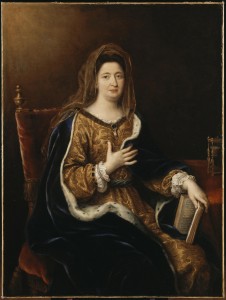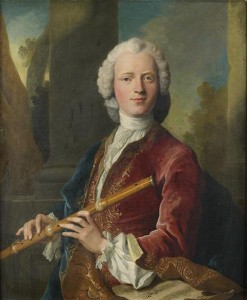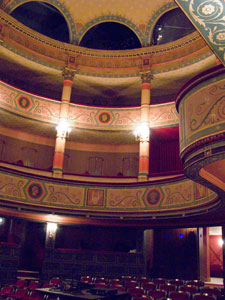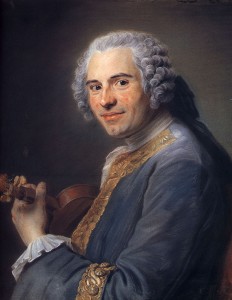Notes for Four Nations concert program for the Pittsburgh Renaissance and Baroque Series (Synod Hall on Saturday, January 12) and at the New Church in New York City (Monday, January 14). Check below blog for details.
I prefer that which moves me to that which surprises me.
–François Couperin (from the preface of Book One of his harpsichord works)
I prefer the bizarre to the insipid.
–Anne Louis Girodet (French painter and student of David)
Eighteenth century France experienced revolution in every quarter. Society, government and art shed one series of long-held assumptions and hacked through thickets of philosophical thought to arrive at new values. From monarch to republic, from political marriage to marriage of affection, from subtle and decorous expression to inflamed, exaggerated, often ugly gesture, the trajectory of change in the eighteenth century rivals that of any epoch before or since. Our program looks at the changing landscape of French music from Versailles to the musician’s private music room to the public concert hall in Paris.

Imagine a concert in the music room of Madame de Maintenon at Versailles. Seated near the King and in the company of ten or fifteen favorites at court, you listen to François Couperin perform at the harpsichord. You enjoy the refined pleasure of a concert royal, a flute sonata of Jacques-Martin Hotteterre, a cantata by Louis-Nicolas Clérambault. Meticulously composed, each phrase is colored with the right chord and just the right turn of melody. The hours spent are luxurious.

Now imagine a concert in the home of the flautist Michel Blavet. Blavet has entertained and performed with the visiting German composer Georg Philipp Telemann, from whom the Frenchman receives a volume of six quartets inspired by the fine musicians Telemann met and admired in Paris. The audience in Blavet’s home, if any at all, consists of connoisseurs of the art. This music is often surprising and delights the mind as we hear a suite in which a French dance is followed by an Italian allegro and then leads to a jauntily exotic Polish dance. Each instrument shines with its unique color and character while an underlying counterpoint confronts the intellect. The hours are engaging and challenging.
Now imagine a public concert hall. A mass of 350 eager

concertgoers has purchased tickets expecting to be astounded by a rush of notes, unidentifiable sounds all unleashed by bow, breath, or finger. The performer on violin, flute, cello or harpsichord, naturally handsome, recognizes himself a star and not a servant or mere craftsman. Expect the very last musical word in Paris, or from Rome, or Venice, and later in the eighteenth century, Mannheim and Vienna. The hours are novel and thrilling.
With origins so different and audiences so diverse how should we recognize and understand this richness? How should we perform a courante by François Couperin, differently from one by François Francoeur?
The embroidered refinement of Couperin’s music, emblematic of the last years of Louis XIV’s reign, challenges any harpsichordist. The simplest and most graceful melodies and delicately spiced harmonies are chiseled with agreements or ornaments, gracing all voices from soprano to bass. There are so many varieties of the trill, so many possibilities of its execution. The right hand might play a trill on the beat while the left executes a trill on the same beat–but delayed a fraction of a second. Couperin notates this clearly, demanding that we adhere to his minute directions. If the result sounds labored or awkward, then we have to work harder to achieve the grace he requires. Listeners hardly register the performer’s care, yet they feel it. This is the realm of noble sensibility and courtly taste. Passion is framed in perfect décor and, as Couperin has requested, moves us without surprising us. Click to hear: Premiere Courante from Troisieme Ordre
Couperin and Hotteterre speak the same language as poet Jean de La Fontaine and dramatist Jean Racine. There is a regular and solid pulse in a dance of Couperin as there is in a verse Fable of La Fontaine or a monologue of Racine. In contrast, the length, shapes and imagery of each word or phrase render the art unpredictable and limpid.
Is there sentiment? We will have to wait for Debussy and Ravel with their Tombeau de Couperin and Homage a Rameau to arrive at tributes as touching and beautifully turned as Couperin’s La Garnier.
Though raised and educated in the world of Couperin, the violinist and composer Jean-Joseph de Mondonville knew that the level of refinement natural to Couperin would not read in Mondonville’s world of the public concert. For the latter, flashes of fashion, the thrill of virtuosity, the perception of entitlement lent by over-voluptuous melody made up the correct sound palate attractive to his subscribers.

Mondonville’s reign at Paris’ Concerts Spirituels coincides with the city’s passion for Antonio Vivaldi. It was Blavet who composed the first French concerto using Vivaldi’s model. Both he and Francoeur sway like a pendulum between Couperin and Arcangelo Corelli. Mondonville’s violin sonatas, so full of vitality, bring us into the world of the Venetian concerto. Vivaldi’s The Four Seasons seem close at hand in La Cacia, the last movement of Mondonville’s F major sonata. Did the fox portrayed in Vivaldi’s Autumn escape, running from one score to another? Mondonville, however, is too original a personality to become a dull imitator. His fiddle takes us to the French countryside and his aria movements are pure Paris redolent of the douceur de vivre of Rococo painter François Boucher.
If it is no surprise that the Italian composers Luigi Boccherini and Domenico Scarlatti could capture the flavor and thrill of Spain, then surely it should not surprise that Telemann captures the allure of Paris. He infuses its bon gout (good taste) with his very Germanic intelligence composing his finest chamber music in the six works we know as the “Paris Quartets.” Telemann conjures the worlds of theater and dance, countryside and city, enriched with pure instrumental sensuality and enlivened with a feather-light wit, creating a world of badinage that we usually think far beyond the natural subtlety of Germans. While Frederick the Great collected the best canvases of Jean-Antoine Watteau for his royal pleasure, The Great Telemann collected the voices of Couperin, Mondonville, Blavet and Francoeur for his “postcards” from Paris. After listening to his musical journal from France, we long to have been there, at court and at concert.
Click to hear: Telemann Paris Q 2 tendrement
Notes by Andrew Appel
For information about the January 12 performance in Pittsburgh: http://www.rbsp.org
For information about the January 14 performance in New York City: http://www.fournations.org
2 responses to “Court and Concert, notes to a program”
This looks so delicious, Andy! I so wish I could be there. I know it will be fabuloso.
Thanks for sharing the background descriptions and music clips! I’m not going to make it to the concert this time here in Pittsburgh, but I really appreciate learning about Four Nations!